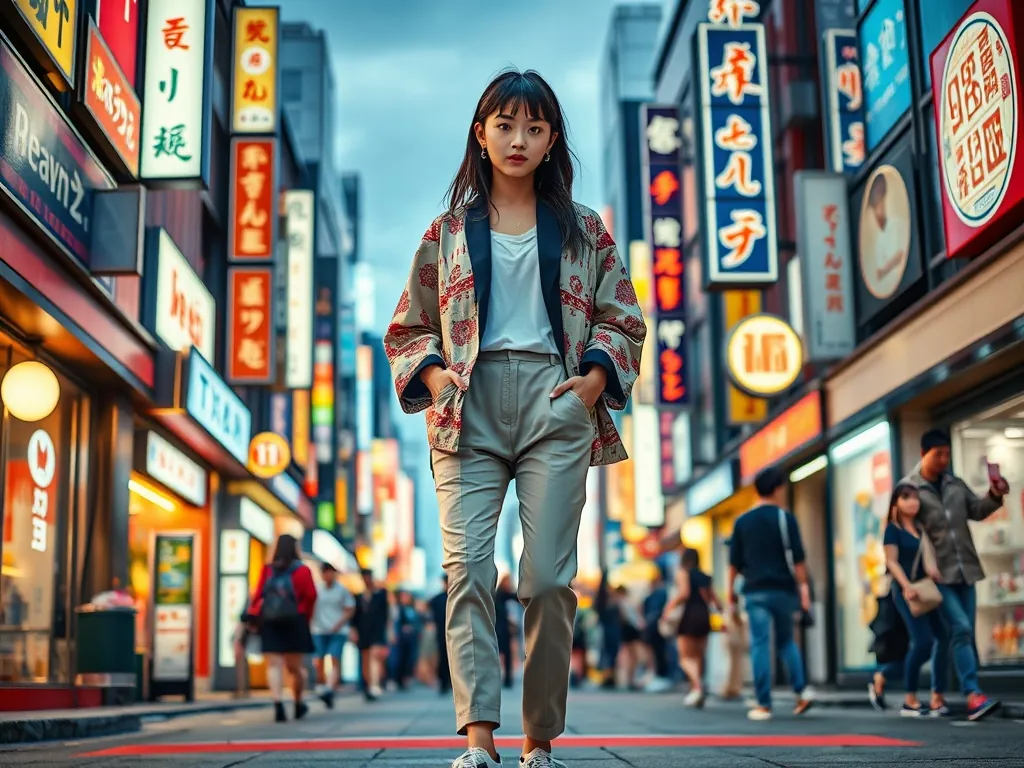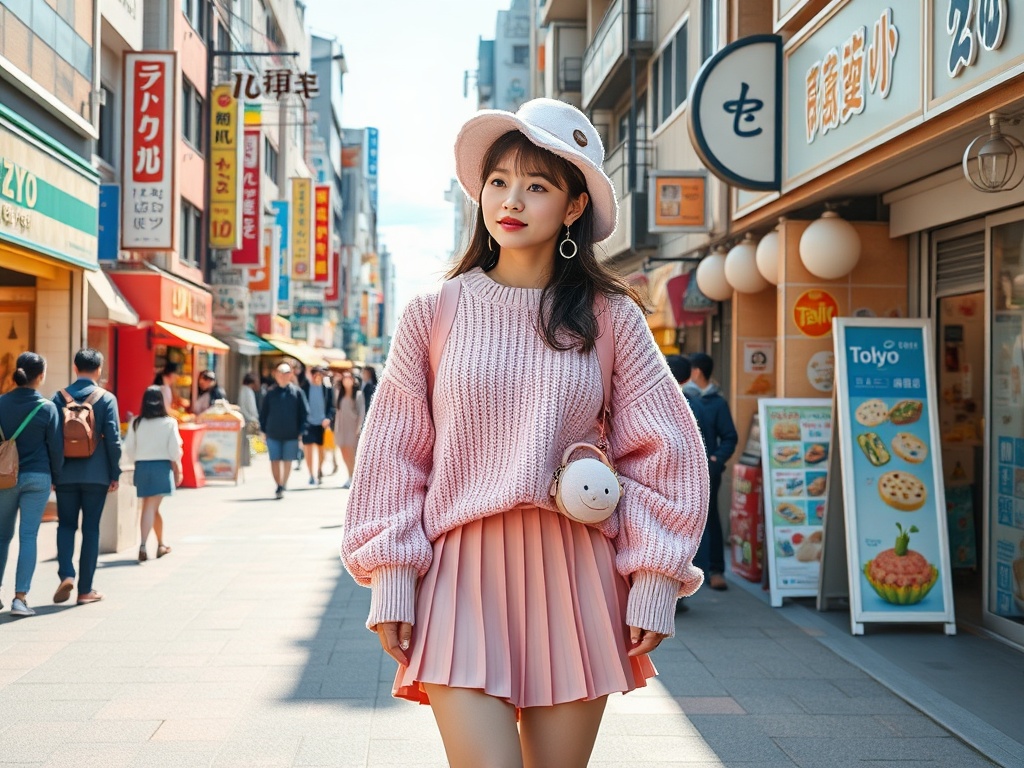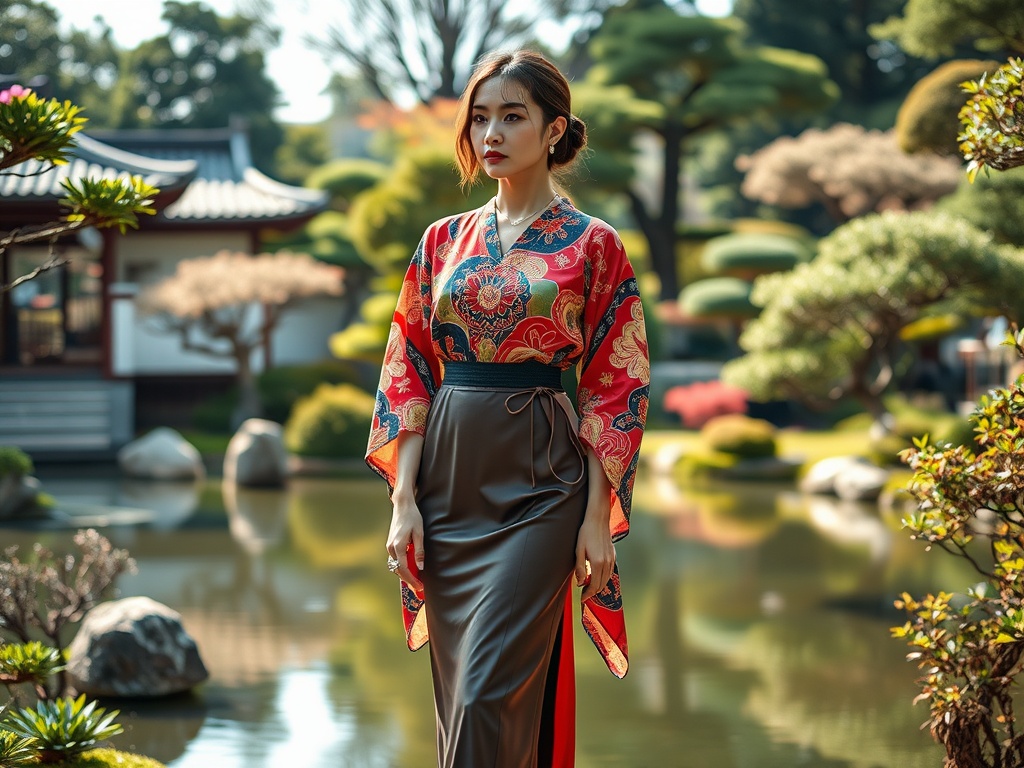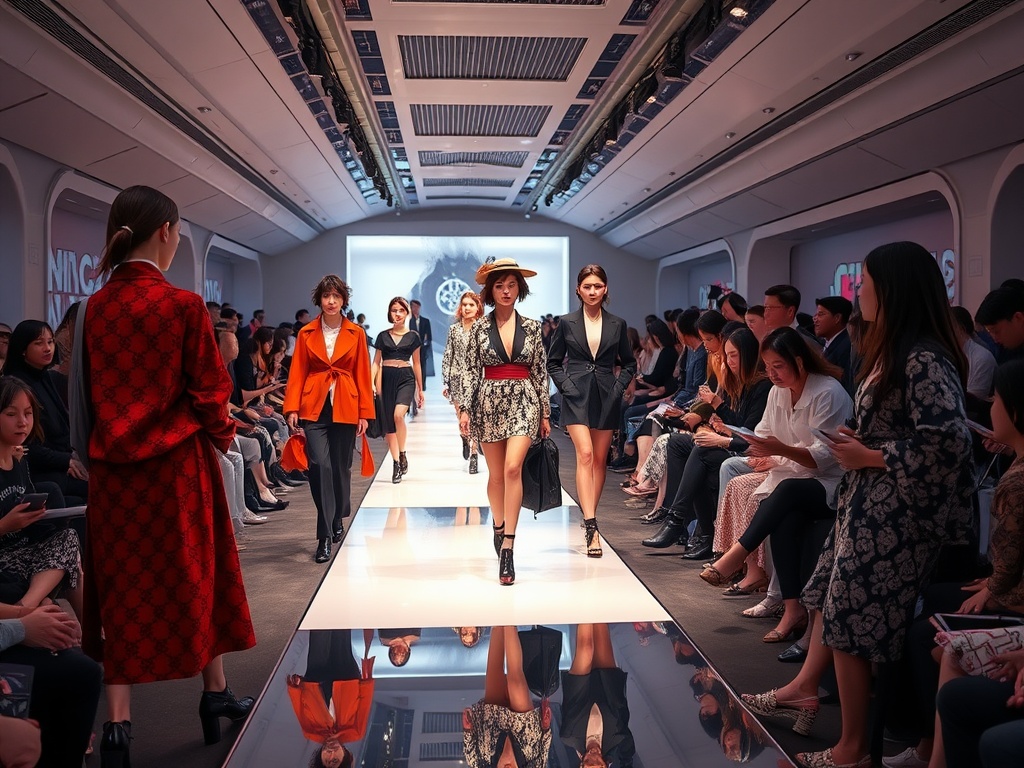Kawaii Culture: The Adorable Charm of Japanese Streetwear
Win a Free Trip to Japan!
Experience cherry blossoms and ancient temples
In the bustling streets of Tokyo and Harajuku, Kawaii Culture reigns supreme, enchanting travelers and fashion enthusiasts alike with its whimsical, eye-catching aesthetics. This fashion movement combines playful elements with a sense of individuality, transforming the streets into a vibrant tapestry of color and creativity. Whether you’re a seasoned fashionista or a curious traveler, exploring the world of Japanese streetwear offers a delightful glimpse into a culture that celebrates charm, cuteness, and creativity.
Kawaii, which translates to ‘cute’ in English, is a cultural phenomenon that extends far beyond its literal meaning. It embodies a lifestyle that embraces innocence and playfulness, often characterized by oversized garments, pastel colors, and quirky accessories. This subculture has become a significant part of Japanese identity, influencing everything from fashion and entertainment to technology and consumer goods.
For a deeper understanding of Kawaii fashion, consider visiting iconic districts like Harajuku, where you’ll find an array of boutiques and shops showcasing the latest trends in Japanese streetwear. From frilly skirts to graphic tees, every piece tells a story of imagination and joy.
To truly experience the charm of Kawaii fashion, consider incorporating some key elements into your look. These items are not only popular among locals but also make for unique souvenirs to bring back home.
- Pastel Colors: Soft hues like pink, lavender, and mint green are staples in Kawaii fashion, adding a dreamy touch to any outfit.
- Graphic Tees: Featuring cute characters and whimsical designs, these tops are perfect for expressing your playful side.
- Oversized Sweaters: Cozy and comfortable, oversized sweaters often come with adorable motifs and patterns.
- Unique Accessories: From plush backpacks to quirky hats, accessories play a crucial role in completing a Kawaii look.
While exploring the Kawaii fashion scene, it’s essential to immerse yourself in the broader cultural context. Here are some travel tips to enhance your experience:
- Visit Harajuku on a Sunday: This is when the district truly comes alive, with locals and tourists alike showcasing their most creative outfits.
- Check out themed cafes: Experience Kawaii culture in themed cafes where you can enjoy adorable treats surrounded by whimsical decor.
- Attend a fashion event: Keep an eye out for street fashion events and festivals, where you can witness the latest trends in action.
From Kimono to Couture: The Fusion of Tradition and Modernity
Japanese fashion has always been a fascinating blend of rich traditions and cutting-edge innovation. This unique combination is especially evident in the realm of women’s fashion, where the timeless elegance of the kimono meets the avant-garde creations of modern designers. For those traveling to Japan, exploring this dynamic interplay offers not just a fashion statement but a cultural experience that spans centuries of artistic expression.
The kimono, with its flowing lines and intricate patterns, serves as a symbol of Japanese heritage and craftsmanship. Originally worn as everyday attire, it has evolved over time, maintaining its ceremonial significance while influencing contemporary fashion. Many modern designers draw inspiration from the kimono’s aesthetic, incorporating its elements into modern silhouettes and textiles. Visitors can witness this blend of old and new at traditional kimono shops as well as in high-fashion boutiques in major cities like Tokyo and Kyoto. This fusion is not just a visual delight but also a testament to Japan’s ability to honor its past while embracing the future.
In recent years, Japan has emerged as a powerhouse in the global fashion scene, with designers like Rei Kawakubo and Yohji Yamamoto leading the charge. They have redefined the boundaries of what’s possible in fashion, often incorporating traditional Japanese techniques and fabrics into their collections. These designers are known for their experimental approach, challenging conventional notions of beauty and style. For travelers interested in fashion, attending a fashion week event in Japan or visiting a designer’s flagship store offers an exciting glimpse into the world of Japanese couture. This sector of fashion is not just about clothing; it’s about artistic expression and cultural dialogue.
Whether you’re strolling through the historic districts of Kyoto or the bustling streets of Shibuya, the influence of both tradition and innovation is ever-present. This harmonious blend makes Japanese fashion an essential aspect of travel for those seeking to understand the country’s unique cultural landscape.
Tokyo Runways: Where Avant-Garde Meets Everyday Style
Tokyo, a city where tradition seamlessly blends with innovation, is the epicenter of modern Japanese fashion for women. Here, the runways are not just a stage for showcasing clothes; they are a canvas where art and fashion converge to create something truly unique. The city’s fashion scene is known for its daring experimentation, where designers push boundaries, crafting collections that are both imaginative and wearable. For fashion-forward travelers, Tokyo offers an unparalleled glimpse into the dynamic interplay between avant-garde creations and everyday style.
The runways of Tokyo are renowned for their bold statements and innovative designs. Fashion shows here are more than mere exhibitions; they are performances that captivate audiences with their creativity and flair. Designers like Junya Watanabe and Issey Miyake have become icons in this realm, known for their ability to transform traditional fabrics into modern masterpieces. Their collections often feature unexpected cuts, vibrant colors, and intricate details that reflect a deep respect for Japanese heritage while embracing contemporary aesthetics. As a traveler, attending a fashion show in Tokyo offers a thrilling experience, where you can witness firsthand the cutting-edge designs that influence global trends.
Tokyo’s fashion scene is not confined to the runways; the streets themselves serve as a vibrant runway, showcasing the eclectic mix of styles that define modern Japanese fashion for women. From the bustling districts of Shibuya to the chic streets of Ginza, everyday fashionistas display an effortless blend of high fashion and streetwear. This fusion of styles is a testament to Tokyo’s ability to redefine fashion norms, offering a rich tapestry of looks that inspire both locals and visitors alike. The street style in Tokyo is characterized by its boldness and individuality, with fashion enthusiasts mixing vintage pieces with contemporary designs to create looks that are both personal and progressive.
Vintage Vibes: Exploring Japan’s Love Affair with Retro Fashion
Japan’s fashion scene is a kaleidoscope of influences where the old and new coexist in perfect harmony. While cutting-edge designs and avant-garde styles dominate the runways, there’s an undeniable charm in Japan’s embrace of retro fashion. This nostalgic journey through fashion history offers travelers a unique perspective on how Japan honors its past while crafting its future. Vintage fashion in Japan isn’t just about clothing; it’s a cultural exploration that invites you to step back in time and experience the allure of bygone eras.
Retro fashion in Japan is more than a trend; it’s a lifestyle. The country’s fascination with all things vintage is evident in its bustling markets and specialized boutiques, where you’ll find an impressive array of garments from the 70s, 80s, and 90s. Japanese designers and fashion enthusiasts have a knack for reimagining classic styles with a modern twist, creating looks that are both nostalgic and fresh. Whether you’re a fan of bold prints, high-waisted silhouettes, or playful accessories, exploring Japan’s retro fashion scene is like uncovering a treasure trove of timeless elegance.
For those eager to dive into retro fashion, Japan offers a myriad of hotspots that cater to vintage lovers. Here are some must-visit places:
- Shimokitazawa: Known as Tokyo’s vintage mecca, this neighborhood is packed with charming shops offering everything from second-hand clothing to unique accessories.
- Koenji: Another Tokyo district famous for its indie vibe, Koenji is home to numerous thrift stores and vintage boutiques that attract a hip crowd.
- Osaka’s Amerikamura: Often compared to Tokyo’s Harajuku, Amerikamura is a vibrant area filled with retro shops that showcase a diverse range of styles and eras.
Japanese fashionistas are masters at blending the past with the present. By incorporating vintage pieces into contemporary wardrobes, they create eclectic looks that celebrate individuality and nostalgia. Whether it’s pairing a vintage blouse with modern denim or accessorizing with classic jewelry, the art of mixing eras is a testament to Japan’s innovative spirit. Travelers venturing into this fashion landscape will find inspiration in the seamless integration of retro elements with modern sensibilities, making it a distinctive style statement.
Fashion Districts Unveiled: A Shopper’s Paradise in Japan
Japan’s fashion scene is a vibrant tapestry where tradition meets innovation, and nowhere is this more evident than in its bustling fashion districts. For travel and tourism enthusiasts, these areas offer more than just shopping; they are cultural landmarks that showcase the diversity and creativity of modern Japanese fashion for women. From the latest trends in streetwear to the elegant fusion of traditional and contemporary styles, these districts are a must-visit for anyone eager to experience the essence of Japanese fashion.
Renowned for its sophisticated atmosphere, Ginza is Tokyo’s premier shopping district, where luxury and fashion converge. With its wide, tree-lined avenues and opulent storefronts, Ginza is the epitome of elegance. Here, international designer brands sit alongside Japanese labels, offering a shopping experience that is both exclusive and exciting. Travelers will find themselves immersed in a world of high fashion, where the latest collections from top designers are displayed in stunning window displays that are works of art in themselves.
For those seeking a more eclectic and youthful vibe, Harajuku is the place to be. Known as the heart of Kawaii Culture, Harajuku is a playground for fashion enthusiasts who delight in the quirky and the unconventional. The district’s narrow streets are lined with shops that offer everything from vibrant streetwear to unique accessories that define Tokyo’s avant-garde style. It’s a hub of creativity, where fashion is a form of self-expression, and every outfit tells a story. Visitors can expect to find an array of boutiques that cater to all tastes, making it a paradise for those who love to experiment with their style.
Shibuya is synonymous with Tokyo’s youthful energy, making it a hotspot for trendsetters and fashion-forward individuals. The iconic Shibuya Crossing is just the beginning; venture into the surrounding streets and discover a plethora of shops that offer the latest in Japanese street fashion. From cutting-edge designs to casual everyday wear, Shibuya is a dynamic district where fashion constantly evolves. It’s an ideal destination for travelers who want to stay ahead of the curve and experience the pulse of Japanese youth culture.
Sustainability on the Rise: Eco-Friendly Fashion Movements in Japan
As the world becomes increasingly conscious of its environmental footprint, Japan’s fashion scene is embracing sustainability with vigor and innovation. For travel and tourism enthusiasts, this shift towards eco-friendly practices in fashion offers a unique lens through which to explore Japan—a country known for its blend of tradition and modernity. The rise of sustainable fashion in Japan is not only a trend but a movement that reflects a deep respect for nature and a commitment to preserving it for future generations.
Eco-Conscious Design: A Blend of Aesthetics and Ethics
In the realm of modern Japanese fashion for women, sustainability is becoming a key focus, reshaping the industry with designs that are as ethical as they are elegant. Local designers are pioneering the use of organic fabrics and natural dyes, creating garments that minimize environmental impact without compromising on style. These eco-conscious designs are a testament to Japan’s ability to merge innovation with aesthetics, offering travelers a chance to indulge in fashion that’s mindful of the planet. Visiting eco-friendly boutiques in Tokyo and Kyoto provides a glimpse into this evolving landscape, where the commitment to sustainability is as evident as the artistry of the pieces themselves.
Community and Craftsmanship: Reviving Traditional Techniques
The sustainability movement in Japanese fashion is also about reviving traditional techniques that emphasize craftsmanship and quality over mass production. In regions like Okinawa and the Noto Peninsula, local artisans are breathing new life into age-old practices such as indigo dyeing and hand-weaving. By integrating these methods into modern designs, Japan is fostering a cultural renaissance that values sustainability through heritage. Travelers interested in this aspect of fashion can explore workshops and events dedicated to these crafts, gaining insight into the sustainable practices that underpin Japan’s fashion industry.
Innovative Recycling: From Waste to Wardrobe
In Japan, the concept of ‘mottainai’—a sense of regret over waste—is driving innovative recycling initiatives within the fashion sector. Brands are increasingly adopting zero-waste patterns and upcycling techniques, transforming discarded materials into stunning fashion pieces. This creative approach not only reduces waste but also showcases the ingenuity and resourcefulness that define Japanese fashion. Tourists exploring the fashion districts of Tokyo can discover these unique collections, where recycling meets style in imaginative ways.
Cultural Influences: How Japanese Fashion Inspires Global Trends
The vibrant world of modern Japanese fashion for women is not just a reflection of Japan’s rich cultural tapestry but a powerful force that shapes global trends. With its unique blend of tradition and innovation, Japanese fashion captivates international audiences, offering a fresh perspective on style and creativity. For travel and tourism enthusiasts, delving into this influential sphere provides a deeper understanding of how Japan’s sartorial ingenuity continues to inspire and reshape fashion landscapes worldwide.
Japanese fashion has a unique ability to transcend borders, making its mark on runways from Paris to New York. Designers like Rei Kawakubo and Issey Miyake have pioneered this movement, bringing their avant-garde aesthetics to the forefront of global fashion. Their work often incorporates traditional Japanese elements, such as intricate patterns and innovative silhouettes, which resonate with international fashionistas. This global influence is a testament to Japan’s ability to fuse heritage with modernity, offering travelers a chance to witness the birthplace of trends that often reverberate worldwide.
Beyond high fashion, Japanese street style is a cultural phenomenon that has captured the imagination of style enthusiasts around the globe. The eclectic and fearless approach of Tokyo’s fashion-forward districts, like Harajuku and Shibuya, offers a playground for creativity that has inspired countless global trends. The bold use of color, layering, and unique accessories seen on these streets encourages fashion enthusiasts to push boundaries and express individuality. For travelers, exploring these vibrant areas provides insights into the grassroots movements that drive Japanese fashion’s international allure.
Whether it’s the minimalist elegance of traditional garments or the eclectic vibrancy of modern streetwear, Japanese fashion continues to be a source of inspiration worldwide. As travelers immerse themselves in Japan’s fashion districts, they not only discover the trends influencing global style but also the cultural narratives that make Japanese fashion a powerful force in the world of design.
Accessorize the Japanese Way: The Art of Perfecting Your Outfit
When it comes to modern Japanese fashion for women, accessories play an integral role in creating a complete and harmonious look. Whether you’re wandering through the stylish streets of Shibuya or exploring the eclectic vibe of Harajuku, the art of accessorizing is a skill that elevates an outfit from ordinary to extraordinary. The Japanese approach to accessories is characterized by a balance of subtlety and statement, where each piece is thoughtfully chosen to enhance and complement the overall ensemble.
Minimalist Elegance is a key theme in Japanese accessorizing. Often, less is more, with a focus on quality over quantity. Jewelry pieces are typically understated yet refined, adding a touch of elegance without overwhelming the outfit. Think delicate earrings, simple bracelets, and minimalist necklaces that complete a look with effortless sophistication. This minimalist approach reflects the traditional Japanese aesthetic of ‘wabi-sabi’, embracing the beauty of simplicity and imperfection.
On the other hand, for those who revel in the bold and the beautiful, Japanese street fashion offers a playground of possibilities. Here, accessories become the centerpiece, with oversized hats, quirky bags, and colorful scarves stealing the spotlight. These statement pieces are often infused with pop culture references, cartoon motifs, and vibrant patterns, transforming the wearer into a walking canvas of creativity. It’s a celebration of individuality where fashion enthusiasts are encouraged to express their unique style and personality.
Beyond jewelry and bags, footwear is another essential element of Japanese fashion. Traditional footwear like zori and geta provide a cultural twist to modern attire, while contemporary styles often feature bold designs and playful elements. Whether it’s a pair of stylish sneakers or elegant sandals, the right footwear can tie together an outfit, offering both comfort and style for a day of exploring Japan’s fashion districts.



